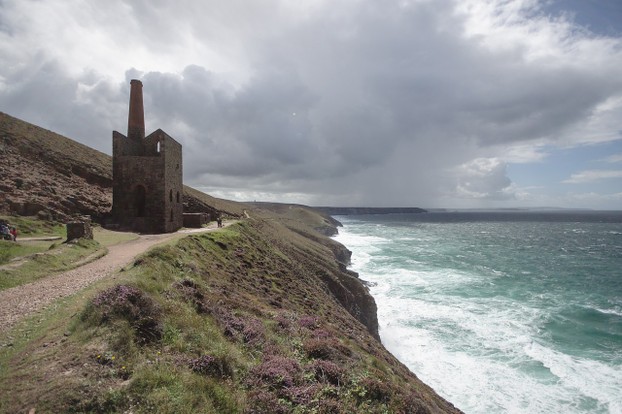After he reaches Tintagel the book enters a new phase, in which the author goes into some detail on the history of Cornwall. This section gives a good account of Cornish history, but there is always the danger of its losing focus on the central question: that of identity. Not that it is ever completely lost, but the history can obscure the question posed in the book. There is a good account of Cornwall in the Reformation period which reveals the imposition of the reforms at the Reformation. The author goes into historical detail of the Cornish risings of that period, which are sometimes overlooked by the history books, which concentrate upon English history, which is focused in the south with northern forays needed to explain national issues.
But local risings cannot provide a satisfactory basis for the Cornish identity. There was only a small proportion of the native Cornish involved, and they provided no enduring political consequences. The rebels were thoroughly defeated, leaving us with the usual legacy of failed heroes and a popular folk song, The Song of the Western Men. Nothing to celebrate really. Mining and fishing have been considered components of the traditional Cornish identity, and it is true that Cornish people often gained a sense of identity from their mining traditions, but neither is a major player in the economic game these days, so what would be left of the traditional identity these days.. Abandoned tin mines crumble in the rocky landscape, their engine houses standing with the chimneys of their engine houses standing defiantly against the sky. China clay is still mined, but it is not the basis of the whole economy. Fishing is still a Cornish staple, but the fishing fleet is much smaller than it was and only employs a small proportion of the local populace.
Hannigan's hike took him over the granite upland of Bodmin Moor, where the famous Jamaica Inn, renowned for its place in literature and feted as a den for smugglers, is sited. The reputedly haunted site is associated with participants in another of Cornwall's historical customs, smuggling, makes its impacts on Cornish historical tradition, but smuggling is not a socially acceptable activity these days and no one would admit to being involved in it.
Hannigan toys with Cornish identity's being tied up with granite, for a batholith of this enduring stone underlies Cornwall, but it only breaks through to the surface at six places, not all of them large.
His route takes him through tourist towns, Polperro, a popular resort which still has a fishing fleet of inshore boats. He finds a liking for Polperro, and feels that it is preserving something of traditional Cornwall while still recognising the importance of tourism. But even at delightful Polperro he is forced to refer to the problem endemic to the county, the problem of second homes, which are squeezing local people, native Cornish, out of the housing market. He sees these as a threat to the enduring population of Cornwall, which is being driven elsewhere by rich people buying up properties. This is undermining the Cornish identity by destroying the longstanding community on which ethnicity depends.







 Pilgrimage. A review16 days ago
Pilgrimage. A review16 days ago
 Leo the Fourteenthon 05/09/2025
Leo the Fourteenthon 05/09/2025
 The Melsonby Hoardon 03/25/2025
The Melsonby Hoardon 03/25/2025



Comments
No one has spoken Cumbric for over a thousand years, so the only knowledge we have about it is from the counting systems still used by sheep farmers, of which there are several across Northern England. This indicates that there was a wide variety of dialects of this lost tongue.
I don't think that there were very many dialects, certainly Cornishbwas not as dialectbdiverse as Welsh or Cumbric.
Thank you!
There are probably any number of Cornish dialects historically, correct?
Has the Cornish-language revival selected one over others or has it perhaps sought to use as many as possible?
Not really, it is just how variant spellings have grown up.
Thank you!
English Wiktionary acknowledges Kernow as the current place name for Cornwall.
It associates it with *Kornowī (“people of the horn”).
It considers that place name as possibly indicative of -- original? -- inhabitants self-addressed as Cornovii.
Is there a pronunciation reason for switching back and forth between the letter "c" and the letter "k"?
Not at all. The association of wealh with slave was just a bit of arrogance by the English, we are quite capable of that. The people of Cornwall are as much descendants of the first settlers of Britain as the Welsh are
Thank you!
English Wikipedia associates the place-name Cornwall with proto-Celtic kamu- ("horn") and Old English wealh ("Brittonic-speaker, foreigner, slave").
Does that mean that the Cornish headland originally was settled by people different from the immediately surrounding area or by slaves?
You would hear the English word.
Thank you!
So British Isle-ers -- ;-D -- no longer know what Wlas means!
Might -- if I moved around from Cornish city to town to village -- I hear the Cornish name?
Or would I -- perhaps 99.9 percent recurring of the time -- only hear Land's End?
Penn an Was. Or Pedn an Wlas. Penn means hill or high.WLAS, pronounced oolas, I do not know